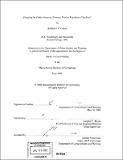| dc.contributor.advisor | Langley C. Keyes. | en_US |
| dc.contributor.author | Carton, Katherine F. (Katherine Frances), 1969- | en_US |
| dc.contributor.other | Massachusetts Institute of Technology. Dept. of Urban Studies and Planning. | en_US |
| dc.date.accessioned | 2011-07-18T14:02:56Z | |
| dc.date.available | 2011-07-18T14:02:56Z | |
| dc.date.copyright | 2002 | en_US |
| dc.date.issued | 2002 | en_US |
| dc.identifier.uri | http://hdl.handle.net/1721.1/64912 | |
| dc.description | Thesis (M.C.P.)--Massachusetts Institute of Technology, Dept. of Urban Studies and Planning, 2002. | en_US |
| dc.description | Includes bibliographical references (leaves 80-84). | en_US |
| dc.description.abstract | The Public Housing Agency (PHA) Plan was introduced in 1998 as part of the landmark Quality Housing and Work Responsibility Act. The stated purpose of this legislation was to reform public housing by "deregulating and decontrolling public housing authorities, thereby enabling them to perform as property and asset managers." The complex, topdown bureaucratic rules and regulations promulgated in Washington were no longer deemed workable. Congress strove to foster a new relationship with public housing authorities that replaced the single, top-down, cookie-cutter approach with the flexibility and local authority necessary to foster individual initiative and develop context-based solutions that recognize the unique nature and dynamics of individual neighborhoods and communities. Yet, upon examination of the statutory and regulatory requirements of the PHA Plan, it becomes evident that Congress and the Department of Housing and Urban Development (HUD) have missed their mark. Unfortunately, neither Congress nor HUD have articulated how deregulation and decontrol will necessarily result in better performance as property and asset managers. Ultimately, this omission undermined Washington's ability to effect its public housing reform agenda. By rigidly prescribing the content and introducing a uniform, electronic format, the PHA Plan appears to be driven more by technology and the ease of the review and approval process than by the needs of public housing authorities and their constituents. More importantly, as demonstrated by a case study of the Boston Housing Authority, the PHA Plan fails to reinforce locally based initiatives designed to revitalize public housing using established real estate principles. Drawing on extensive research, interviews with key actors and the author's own experiences as a planner with the Boston Housing Authority, this thesis will explore the factors that contributed to the disjunction between the stated purpose of the PHA Plan and the way the requirements have actually played out at the local level. Based upon these observations, recommendations are offered to change the statutory and/or regulatory requirements to better serve public housing agencies in their efforts to improve as property and asset managers. | en_US |
| dc.description.statementofresponsibility | by Katherine F. Carton. | en_US |
| dc.format.extent | 84 leaves | en_US |
| dc.language.iso | eng | en_US |
| dc.publisher | Massachusetts Institute of Technology | en_US |
| dc.rights | M.I.T. theses are protected by
copyright. They may be viewed from this source for any purpose, but
reproduction or distribution in any format is prohibited without written
permission. See provided URL for inquiries about permission. | en_US |
| dc.rights.uri | http://dspace.mit.edu/handle/1721.1/7582 | en_US |
| dc.subject | Urban Studies and Planning. | en_US |
| dc.title | Planning for public housing : strategic tool or regulatory checklist? | en_US |
| dc.type | Thesis | en_US |
| dc.description.degree | M.C.P. | en_US |
| dc.contributor.department | Massachusetts Institute of Technology. Department of Urban Studies and Planning | |
| dc.identifier.oclc | 51064920 | en_US |
